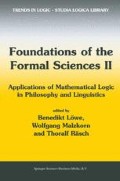Abstract
This paper presents the Gupta-Belnap Fixed-Point problem: to characterize the truth-functional schemes of the first-order logic such that, for every interpreted language L, a truth predicate for L can be defined in L using a Kripkean fixed-point. A propositional version of the problem is defined using the stipulation logic of A. Visser and then the strategy adopted for the solution to the three-valued case is presented, using the theory of clones of functions.
The author wants to thank Rafael Beneyto Torres for his constant help during the preparation of this work and the financial support offered by the grants of the Generalitat Valenciana (F.P.I.) and Fundación Caja de Madrid.
Access this chapter
Tax calculation will be finalised at checkout
Purchases are for personal use only
Preview
Unable to display preview. Download preview PDF.
References
We make this restriction for the sake of simplicity, but using codification we could get rid of it.
See the examples of Saul Kripke in [Kri175].
Cf. [Vis89] and [GupBel93].
We will use as the set of truth values in three-valued logics the set Λ3 = {0, 1, 2}, {0,1} being the classical values and 2 the value ‘is neither true nor false’.
Cf [Kri175].
The original problem (cf. [GupBel93, p. 63]) was restricted to three and four-valued schemes, because the most important many-valued logics proposed as solutions to paradoxes have three or four values.
Cf. [Vis89].
This case is easy, but not interesting, as it can be proved that the maximal bivalent clone that has the fixed-point property is the one generated by classical conjunction and disjunction.
As it is usual in the theory of algebras of functions, we represent a relation as a matrix, whose columns are the elements of the relation.
The proposition is a corollary of the Theorem 2 and the characterization of all the two-valued clones given by Post in [Pos4l].
Author information
Authors and Affiliations
Editor information
Editors and Affiliations
Rights and permissions
Copyright information
© 2003 Springer Science+Business Media Dordrecht
About this chapter
Cite this chapter
Fernández, J.M. (2003). The Gupta-Belnap Fixed-Point Problem and the Theory of Clones of Functions. In: Löwe, B., Malzkom, W., Räsch, T. (eds) Foundations of the Formal Sciences II. Trends in Logic, vol 17. Springer, Dordrecht. https://doi.org/10.1007/978-94-017-0395-6_13
Download citation
DOI: https://doi.org/10.1007/978-94-017-0395-6_13
Publisher Name: Springer, Dordrecht
Print ISBN: 978-90-481-6233-8
Online ISBN: 978-94-017-0395-6
eBook Packages: Springer Book Archive

